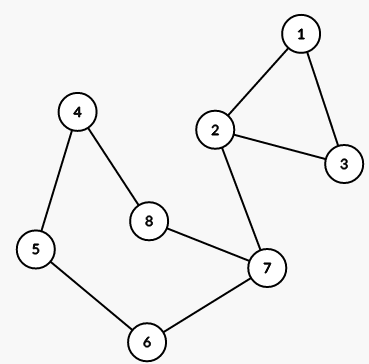CF901C.Bipartite Segments
普及/提高-
通过率:0%
AC君温馨提醒
该题目为【codeforces】题库的题目,您提交的代码将被提交至codeforces进行远程评测,并由ACGO抓取测评结果后进行展示。由于远程测评的测评机由其他平台提供,我们无法保证该服务的稳定性,若提交后无反应,请等待一段时间后再进行重试。
题目描述
You are given an undirected graph with n vertices. There are no edge-simple cycles with the even length in it. In other words, there are no cycles of even length that pass each edge at most once. Let's enumerate vertices from 1 to n .
You have to answer q queries. Each query is described by a segment of vertices [l;r] , and you have to count the number of its subsegments [x;y] ( l<=x<=y<=r ), such that if we delete all vertices except the segment of vertices [x;y] (including x and y ) and edges between them, the resulting graph is bipartite.
输入格式
The first line contains two integers n and m ( 1<=n<=3⋅105 , 1<=m<=3⋅105 ) — the number of vertices and the number of edges in the graph.
The next m lines describe edges in the graph. The i -th of these lines contains two integers ai and bi ( 1<=ai,bi<=n ; ai=bi ), denoting an edge between vertices ai and bi . It is guaranteed that this graph does not contain edge-simple cycles of even length.
The next line contains a single integer q ( 1<=q<=3⋅105 ) — the number of queries.
The next q lines contain queries. The i -th of these lines contains two integers li and ri ( 1<=li<=ri<=n ) — the query parameters.
输出格式
Print q numbers, each in new line: the i -th of them should be the number of subsegments [x;y] ( li<=x<=y<=ri ), such that the graph that only includes vertices from segment [x;y] and edges between them is bipartite.
输入输出样例
输入#1
6 6 1 2 2 3 3 1 4 5 5 6 6 4 3 1 3 4 6 1 6
输出#1
5 5 14
输入#2
8 9 1 2 2 3 3 1 4 5 5 6 6 7 7 8 8 4 7 2 3 1 8 1 4 3 8
输出#2
27 8 19
说明/提示
The first example is shown on the picture below:

For the first query, all subsegments of [1;3] , except this segment itself, are suitable.
For the first query, all subsegments of [4;6] , except this segment itself, are suitable.
For the third query, all subsegments of [1;6] are suitable, except [1;3] , [1;4] , [1;5] , [1;6] , [2;6] , [3;6] , [4;6] .
The second example is shown on the picture below:
